
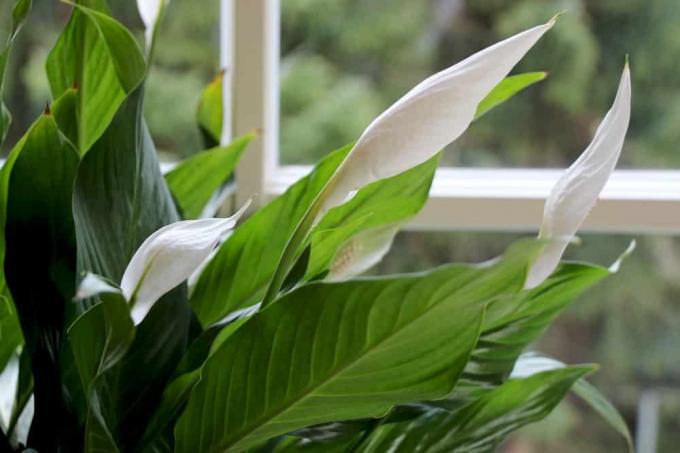
Table of contents
- One colour, many possible causes
- Provide a location with optimal lighting conditions
- Avoid temperatures below the tolerance limit
- Ensure near-tropical humidity
- Adjust watering as needed
- Conscious dosage of nutrients
- Check for pest infestation
- Check if repotting is due
- Always check care from A to Z
- What to do with brown leaves
Glossy green leaves sprout from a low, almost imperceptible trunk on numerous long stalks. A few cream-colored spadix follow in summer, each framed by a white bract. More elegance is not possible. If the color brown pushes itself unattractively in between, the single leaf is not entirely satisfied with its living conditions. Now it's time to find out what's bothering you and adjust it again according to your wishes.
One colour, many possible causes
The care of a houseplant includes a bunch of different activities. Mistakes can be made with almost every one of them. The single leaf usually responds to this by turning its leaves brown. However, if maintenance ignores its needs for a long time, the otherwise very robust plant could eventually die altogether. It is therefore important to find out about the needs of Spathiphyllum, as this ornamental plant is called botanically, and to compare them with the actual circumstances. In particular, you should check these aspects:
- lighting conditions
- room temperature
- humidity
- pouring behaviour
- Fertilize
- Possibly. pest infestation
- pot size
Provide a location with optimal lighting conditions
The single-leaf plant comes from the tropics, where countless plants grow close together and therefore have to compete for light. Hardly any of them can claim the full brightness for themselves and has necessarily adapted to the lack of light in their development, including this plant.
- must not be exposed to direct sunlight
- gets by with little daylight
- semi-shady place is optimal
- also thrives well in the shade
- North window is ideal
- Avoid south-facing windows at all costs
If the current location does not have the characteristics described above, you should definitely treat your houseplant to a change of location. Brown leaf tips in particular are a sure sign of too much direct sun.
Avoid temperatures below the tolerance limit
It goes without saying that a tropical plant like the Spathiphyllum loves warmth. This is also the reason why it is only cultivated as a houseplant in this country. It's not just about avoiding winter frosts outdoors, the single leaf also doesn't like low plus temperatures.
- 18 to 25 degrees Celsius are ideal
- in winter it can be a bit cooler than in summer
- but never fall below 16 degrees Celsius
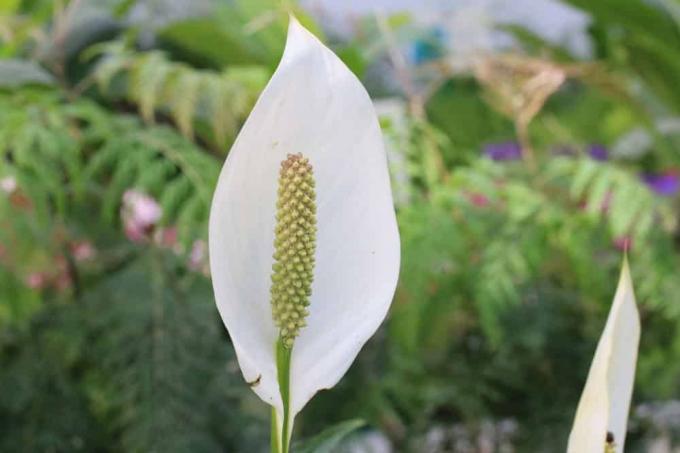
Inhabited rooms usually have a room temperature that is in the comfort zone of this plant. The cold is therefore rarely the cause of brown leaves, but occasionally this is true. For example, if the houseplant is in an unheated stairwell, the temperature could drop too low in a cold winter. Make sure that the single sheet does not have to get to know temperatures below 16 degrees, if necessary have to move it in winter.
Ensure near-tropical humidity
High humidity of around 70%, which is the norm in the tropics, will hardly be possible in the rooms we live in. Fortunately, deviations are tolerated by the plant to a certain extent. As I said: to a certain extent! If the air is too dry, the leaves turn brown. Measure the humidity with a hygrometer, which you can buy cheaply in stores. The following conditions are acceptable for Spathiphyllum:
- at least It should be 50% humidity
- There are problems on warm summer days
- then the air is very dry
- regularly spray the leaves with water
- not the flowers
- the bathroom offers the ideal warm, humid environment
- Put some water in the saucepan for evaporation
- Place the plant on larger pebbles
- this prevents the roots from standing in the water
Tip:
Make sure you use soft water not only when watering, but also when spraying the leaves. Collected rainwater is ideal, but depending on the degree of hardness, tap water may need to be be descaled beforehand.
Adjust watering as needed
Watering indoor plants is not as easy as it first appears. A bit of tact is always required. Very often it is said to keep constantly moist but not to cause moisture. This moto also applies to Spathiphyllum. Only the top layer of soil is allowed to dry for a short time. Therefore, the following applies to casting:
- do not water at fixed intervals
- examine the soil beforehand
- Adjust the amount of water as needed
- water more often and more on warm days
- water more sparingly from October to January
- generally prefer to water more often with smaller amounts
- use room-warm, decalcified water
- pay attention to peaty, slightly acidic substrate
- additionally spray leaves on warm days
Tip:
The oak leaf is considered one of the best plants for hydroponics. This type of cultivation makes moisture regulation easier.
Conscious dosage of nutrients
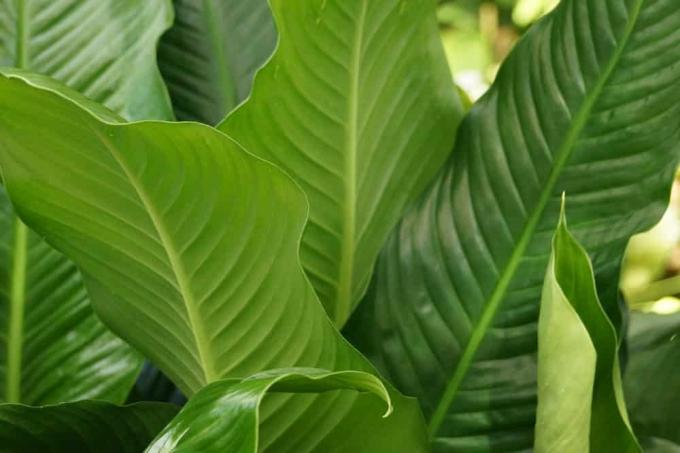
The single-leaf plant needs nutrients to thrive. In the first few weeks after planting, the fresh soil still offers plenty of it. After that, the nutrient depot must be replenished regularly.
- Fertilize every two weeks during flowering
- with a liquid fertilizer
- Water the plant well beforehand
- Be sure to follow the dosage recommendations
- only fertilize every three weeks in winter
If you measure the amount of fertilizer by feel, you can quickly over-fertilize the plant. The single sheet with brown leaf tips shows his displeasure with a well-intentioned supply.
Tip:
If the nutrient supply has been plentiful over a long period of time, the soil should be replaced better.
Check for pest infestation
If the wish for consistently moist soil is not fulfilled, another threat to the beautiful green of the leaves is imminent: spider mites. These occur more frequently when the soil dries out severely. Their presence also leads to brown leaves.
- Check the plant regularly for infestation
- yellow spots on leaves are a possible clue
- isolate plant
- rinse off with water
- treat with neem oil
Tip:
Be sure to check neighboring houseplants for spider mites as well, as they like to hop from plant to plant.
Check if repotting is due
Repotting may be necessary for two reasons. For one, the current pot may have become too small. The roots don't have enough space to grow and can no longer nourish the plant well. The result is brown leaves. It is also possible that part of the roots are damaged by waterlogging. The plant dies of thirst because it cannot absorb enough water from the damaged roots.
- Cut off broken roots with a sharp knife
- Repot the plant in fresh soil
After some time, the growth will recover and form new, healthy roots. So the future belongs exclusively to the green leaves.
Always check care from A to Z
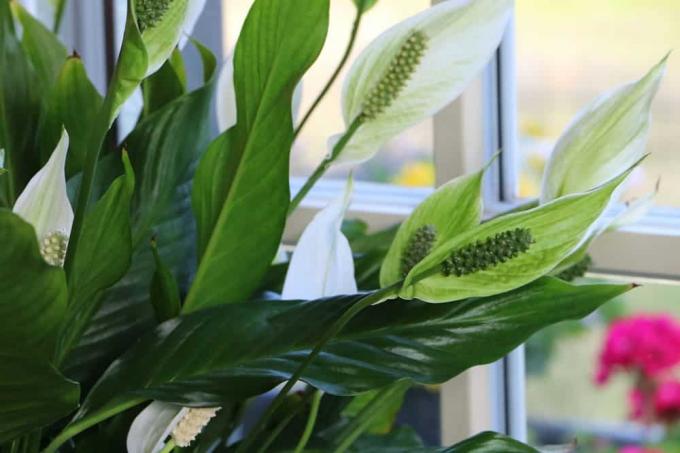
For example, if you've found that your specimen is getting too much sun, you've discovered a likely cause of brown leaves. Giving it a new stand is the only correct consequence. Nonetheless:
- the search for the cause must not stop at this point
- there may well be several causes at the same time
- e.g. B. Over-fertilization and air that is too dry
Then the new location will not be able to completely remedy the situation. If you then start looking for the cause again a few days later, it could be too late for the vitality of the plant.
What to do with brown leaves
Brown leaves don't have to spoil the beautiful sight. They can be cut off the plant with sharp scissors. If they have already dried up, they can often be removed from the plant by hand.
 Home editorial office
Home editorial office
Learn more about houseplants

16 cat-friendly houseplants
If you share an apartment with a cat, you should not have any poisonous indoor plants, because cats occasionally eat the greenery. There are many cat-friendly houseplants that are harmless and can recover quickly once a cat has bitten them.
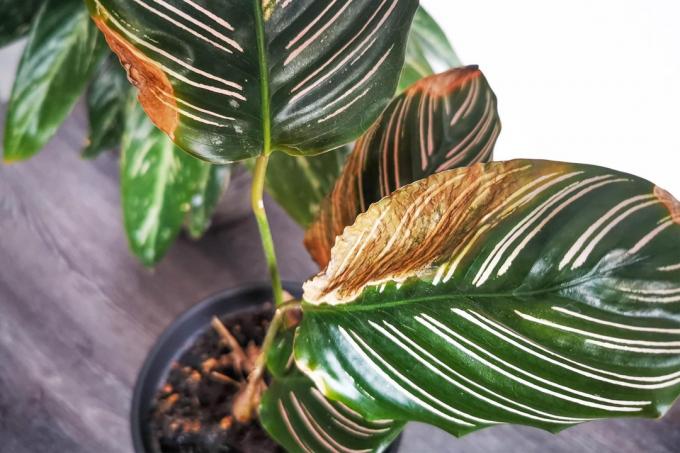
Calathea gets brown leaves: how to save?
The foliage of a calathea, also known as a basket marante, has its price. And that doesn't mean the purchase price. The tropical plant wants to be cared for and feels like it is in its native rainforest. She expresses her dissatisfaction with unfavorable living conditions with brown leaves.

Monstera droops leaves: what to do?
Its serrated leaves make the Monstera one of the most popular indoor plants. But what can be the reason for it letting the leaves droop, and what can you do about it?
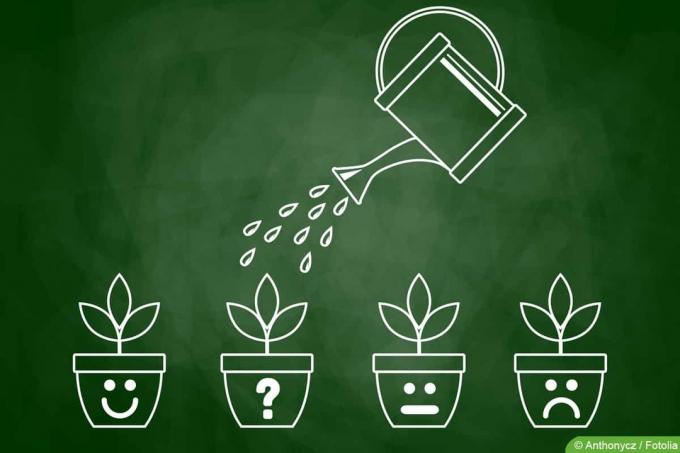
Water houseplants properly 15 tips for potted plants
Watering indoor plants properly sometimes turns out to be more difficult than expected. There are certain points you need to keep in mind when watering your indoor plants so they can show off their full glory. 15 tips on the subject can be found in this guide.

Efeutute, Epipremnum aureum: care from A - Z
The ivy or Epipremnum aureum is one of the most popular houseplants par excellence and is also ideal for people without a green thumb. You can find out how to care for the plant from A - Z here.

Christmas Cactus Losing Buds: 6 Reasons & Solutions
The Christmas cactus is a real feast for the eyes in the living room from late summer with its beautiful flowers. Unfortunately, it often happens that the houseplant loses its buds. Find out here what causes the buds to fall and how you can counteract them.



